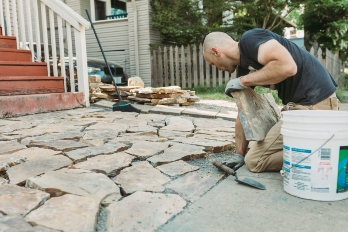This is part of our ongoing series on home maintenance basics to help you keep up your home and grow your investment with confidence.
If you’re anything like us, by the time spring rolls around, you’re anxious to unpack your deck furniture and fire up the grill. But before you begin lounging, it might be a good idea to give your deck a bit of TLC.
According to a study published by the National Association of Home Builders, together with Bank of America, the average deck should last about 20 years. This longevity requires maintenance along the way, however. An annual once-over and some basic upkeep can keep your deck healthy for the long haul.
Among the topics we’ll cover in this post are:
- How to inspect your deck for cleanliness and hazards
- When and how to clean it
- When and how to sand it
- The difference between painting, sealing, and staining
Let’s “deck” down to business:
Inspecting your deck
Your deck lives outside 365 days a year. Though it bravely stands up against the elements, weather can really take a toll on its structure, fasteners, and hardware. A yearly inspection before putting too much weight on your deck is a good idea.
There are four major components to any deck: the posts, the frame, the decking, and the railing. Let’s take a look at each of these and go over what you should watch out for (and keep in mind that while it is possible to DIY some deck fixes, anything structural, like the posts and beams, frame, or railing should be handled by a carpenter or other pro):
1. Posts and beams
The posts are the legs your deck stands on. They’re usually made of pressure-treated 4”x4” lumber and typically rest on concrete piers or footings. The footings may be partially or completely buried. Beams often run from post to post to provide a foundation for the frame.
Here’s what to check for in your posts and beams:
- Are the posts and beams sturdy and stable? They shouldn’t shift when you push or lean on them, or when you walk on your deck.
- Do you see any cracks, holes, or rot? If you poke the posts with a screwdriver, they should feel solid.
- If you can see the cement footings, are they stable and level? Do they have cracks larger than 1/8 inch?
2. Frame
The frame rests on the posts and beams. The boards are typically made of pressure-treated 2”x6” or 2”x8” lumber. The part that attaches to the house is called a “ledger,” and the board on the outside is the “header.” Between them, joists run from front to back, spaced every 16 inches to provide a surface for the decking to sit on. The joists should to secured to the ledger and header with metal hangers.
Here’s what to check for in your frame:
- Are the joists sturdy and stable? They shouldn’t be bowed or bouncy.
- Do you see any cracks, holes, or rot? If you poke it with a screwdriver, the wood should feel solid.
- Are the hangers at either end of the joists rusted, bent, broken, or missing?
3. Decking
Decking is the surface that you walk on. There are many kinds of decking materials, including pressure-treated wood, non-treated wood, and composite boards made of plastics and wood fibers.
Here’s what to check for in your decking:
- Is the decking damaged or are any pieces missing? Damaged or missing decking can be a hazard.
- Is the decking stained? Black and green stains could be mold, mildew, or algae. It can be slippery when wet and cause rot.
- Are the nails or screws sticking out, rusted, or otherwise damaged? Are there any boards that are loose or uneven? Make sure nails or screws rest slightly below the surface of the boards.
4. Railing
Decks that stand higher than 30 inches off the ground should have rails that are at least 3 feet high. Deck rails come in a variety of designs, but they’re often guarded with horizontal boards or vertical posts, called balusters.
(Pro note: Railings are meant to prevent injury and it’s best not to lean against them. Have a seat on your patio furniture instead.)
Here’s what to check for in your railing:
- Are the rails sturdy and stable? They shouldn’t move if you push them.
- Are there missing or damaged boards or balusters? The balusters and boards do more than just make the railing look nice. They provide structural support.
- Are the nails sticking out, rusted, or otherwise damaged? Make sure nails or screws rest slightly below the surface of the boards.
Protect your deck: Cleaning, sanding, and resealing
After you’re sure the deck is sturdy, cleaning and resealing is the next order of business. Though cleaning is a yearly job, you may decide not to put the effort into resealing your deck every year. That’s OK, though the pros recommend not waiting longer than three years to do a full resealing.
In terms of supplies for cleaning and resealing, all you really need is a hose, a pole sander, a putty knife, paint brushes, and a few cans of stain, sealant, or paint. The work can be labor-intensive, however. Don’t feel bad if you’d rather spend your weekend doing something else. Go ahead and hire someone to do the job if you feel so inclined.
Either way, familiarity with the process can make sure you or your handyperson does the job right!
Cleaning
Cleaning your deck is a little more involved than a simple sweeping. Dirt and debris caught between boards can hold moisture, which can lead to rot and mold. You can use a putty knife to remove anything stuck between the decking.
The decking also needs a thorough scrubbing to remove grime, mildew, mold, and grease stains. Good old soap and water can clean dirt, but you may need something stronger for mildew, mold, and grease stains. Hardware stores sell deck cleaning products that are designed specifically for this purpose. Be sure to protect any plants near your deck during cleaning. Harsh products can cause them serious harm.
Head’s up: Though pressure washing can make the cleaning process much easier, it can damage your deck. Too much water pressure can gouge the surface and force water into the wood, which extends the drying time. If you decide to use one, use it with caution.
Sanding
Sanding removes leftover stain, paint, or sealant, and also helps prepare the surface for the new coat. If you don’t sand, you may be disappointed with the outcome. Any remaining stain or sealant can prevent the new coat from properly drying and can leave your deck unprotected.
You may be wondering, do I need to expend the energy to thoroughly scrub my deck before I sand it? We recommend that you do. Sandpaper will work much more effectively it’s used directly on thed decking, rather than having to go through mildew or moss first.
Before sanding, make sure the deck is completely dry. You can test the dryness by sprinkling a little bit of water on the wood. If the water beads up on the surface, it’s still too wet. If it sinks into the wood quickly, you should be good to go.
A pole sander with 80 to 120 grit sandpaper is probably the best way to sand your deck. The pole sander allows you to sand from a standing position, which protects your back, but you can also use an orbital sander.
Sand in the direction of the grain of your wood. When you’re finished, sweep and hose down the deck to remove sawdust.
Staining, painting, and sealing
It’s important to know the difference between stains, paints, and sealants before making a decision on how to coat your deck. Each of these products has its own benefits and shortfalls. Let’s take a quick look at each:
- Stains include pigmentation that adds color to your deck. The pigments can help prevent damage from the sun’s UV rays. Typically, the darker the stain, the better protection. They don’t, however, offer the same level of water protection as paint or sealants.
- Paints, both latex and oil-based, protect against UV rays and water damage. They tend show cosmetic damage quicker than stains. Paint can also trap moisture, leading to rot. The deck needs to be completely dry before painting.
- Sealants are primarily used to block water. They contain water repellants and are thicker than stains. Unlike stains and paints, they don’t have pigmentation, so they don’t offer the same protection against the sun’s UV rays.
Be careful: If you have composite decking, make sure you check with the manufacturer for maintenance details. Sanding, harsh cleaners, and other chemicals can damage your composite decking.
So, how do you choose? There’s no right or wrong answer to this question. It’s mostly a matter of taste. Do you prefer a solid color? Do you want to cover up blemishes? Or do you want to bring out that beautiful wood grain?
There are a couple of things to keep in mind. If your deck has been previously painted, it might make sense to repaint it instead of staining it. If you decide to stain an already painted deck, you will have to get all of the old paint off. This can be a real pain. Paint also does a better job of hiding minor imperfections in older decks, so if your deck is older or a little banged up, paint might be the best choice.
As mentioned, stain can bring out the beauty of your deck’s wood grain. It also allows the wood to breathe better than paint, so for decks that are close to the ground where it is moist, stain can fare better than paint. If you decide to stain, consider applying a sealant on top to protect against water. You can also buy a stain and sealant combo that has the two products already mixed together.
If you have composite decking, you may not need to coat it, but don’t forget about your deck’s frame and rails. If they’re made of wood, they will benefit from some kind of protection.
Well, we’re sorry if we interrupted you on your way out to the grill! But taking the time to care for your deck will extend its life span, make it look better, and generally benefit you in the long run.
For other home maintenance tips, check out these posts:
- Quick household changes to reduce your home’s carbon footprint.
- Easy ways to keep up with your kitchen.




